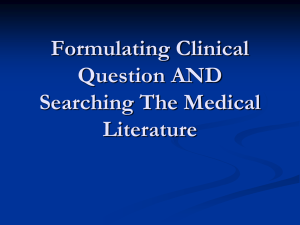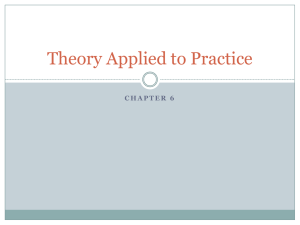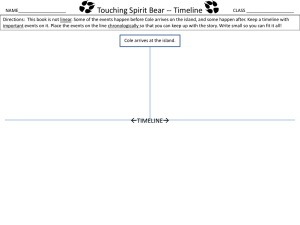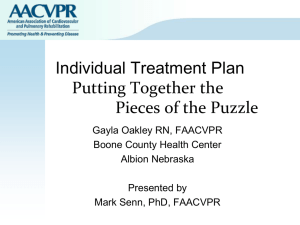Document
advertisement
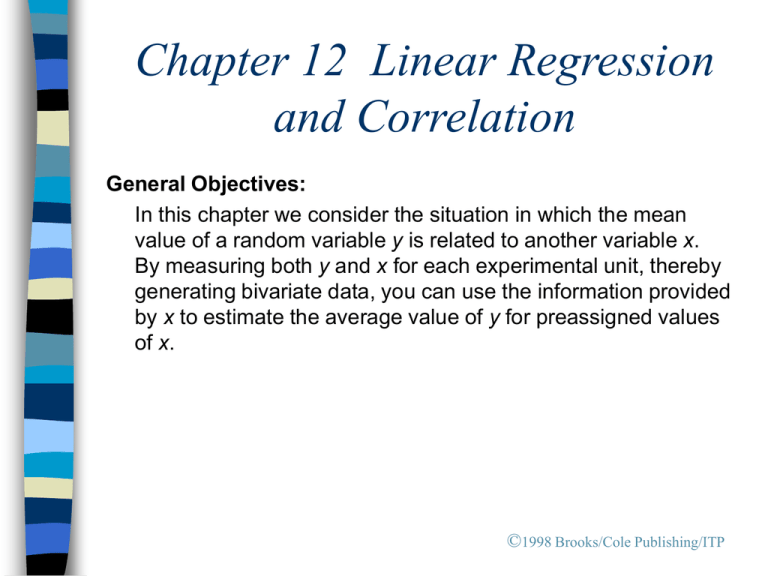
Chapter 12 Linear Regression and Correlation General Objectives: In this chapter we consider the situation in which the mean value of a random variable y is related to another variable x. By measuring both y and x for each experimental unit, thereby generating bivariate data, you can use the information provided by x to estimate the average value of y for preassigned values of x. ©1998 Brooks/Cole Publishing/ITP Specific Topics 1. A simple linear probabilistic model 2. The method of least squares 3. Analysis of variance for linear regression 4. Testing the usefulness of the linear regression model: inferences about b, The ANOVA F Test, and r 2 5. Estimation and prediction using the fitted line 6. Diagnostic tools for checking the regression assumptions 7. Correlation analysis ©1998 Brooks/Cole Publishing/ITP 12.1 Introduction You would expect the college achievement of a student to be a function of several variables: - Rank in high school class - High school’s overall rating - High school GPA - SAT scores The objective is to create a prediction equation that expresses y as a function of these independent variables. This problem was addressed in the discussion of bivariate data. We used the equation a straight line to describe the relationship between x and y and we described the strength of the relationship using the correlation coefficient r. ©1998 Brooks/Cole Publishing/ITP 12.2 A Simple Linear Probabilistic Model In predicting the value of a response y based on the value of an independent variable x, the best-fitting line y = a + bx is based on a sample of n bivariate observations drawn from a larger population of measurements, e.g., the height and weight of 100 male students at a given university. To construct a population model to describe the relationship between y and x, assume that y is linearly related to x. Use the deterministic model y = a + b x where a is the y-intercept, the value of y when x = 0 and b is the slope of the line, as shown in Figure 12.1. ©1998 Brooks/Cole Publishing/ITP Table 12.1 displays the math achievement test scores for a random sample of n = 10 college freshmen, along with their final calculus grades. A plot appears in Figure 12.2. Table 12.1 Student 1 2 3 4 5 6 7 8 9 10 Mathematics Achievement Test Score 39 43 21 64 57 47 28 75 34 52 Final Calculus Grade 65 78 52 82 92 89 73 98 56 75 ©1998 Brooks/Cole Publishing/ITP Figure 12.2 Scatterplot of the data in Table 12.1 ©1998 Brooks/Cole Publishing/ITP Notice that the points do not lie exactly on a line, but rather seem to be deviations about an underlying line. A simple way to modify the deterministic model is to add a random error component to explain the deviations of the points about the line. A particular response y is described using the probabilistic model y = a + b x + e . The first part of the equation, a + b x—called the line of means— describes the average of y for a given value of x. The error component e allows each individual response y to deviate from the line of means by a small amount. ©1998 Brooks/Cole Publishing/ITP Assumptions About the Random Error: Assume that the values of e satisfy these conditions: - Are independent in the probabilistic sense - Have a mean of 0 and a common variance equal to s 2 - Have a normal probability distribution These assumptions about the random error e are shown in Figure 12.3 for three fixed values of x. You can use sample information to estimate the values of a and b, which are the coefficients of the line of means, E y x = a + b x These estimates are used to form the best-fitting line for a given set of data, called the least squares line or regression line. ©1998 Brooks/Cole Publishing/ITP Figure 12.3 Linear probabilistic model ©1998 Brooks/Cole Publishing/ITP 12.3 The Method of Least Squares The formula for the best-fitting line is yˆ = a + bx where a and b are the estimates of the intercept and slope parameters a and b, respectively. The fitted line for the data in Table 12.1 is shown in Figure 12.4. The vertical lines drawn from the prediction line to each point represent the deviations of the points from the line. ©1998 Brooks/Cole Publishing/ITP Figure 12.4 Graph of the fitted line and data points in Table 12.1 ©1998 Brooks/Cole Publishing/ITP Principle of Least Squares: The line that minimizes the sum of squares of the deviations of the observed values of y from those predicted is the best-fitting line. The sum of squared deviations is commonly called the sum of squares for error (SSE) and defined as SSE = y i yˆ i 2 = y i a bx i 2 In Figure 12.4, SSE is the sum of the squared distances represented by the vertical lines. a and b are called the least squared estimators of a and b . ©1998 Brooks/Cole Publishing/ITP Least Squares Estimators of a and b : S xy b= and a = y b x S xx where the quantities Sxy and Sxx are defined as S xy and ( x i )( y i ) = x i x y i y = x i y i n Sxx = xi x = x 2i 2 ( x i )2 n The sum of squares of the x values is found using the shortcut formula in Chapter 2. The sum of the cross-products is the numerator of the covariance defined in Chapter 3. (See Example 12.1 on page 519.) ©1998 Brooks/Cole Publishing/ITP Making sure that calculations are correct: - Be careful of rounding errors. - Use a scientific or graphing calculator - Use computer software. - Always plot the data and graph the line. 12.4 An Analysis of Variance for Linear Regression In a regression analysis, the response y is related to the independent variable x. The total variation in the response variable y, given by Total SS = S yy = y i y = y i 2 2 y i 2 n is divided into two portions: - SSR (sum of squares regression) measures the amount of variation explained by using the regression line with one independent variable x - SSE (sum of squares error) measures the “residual” variation in the data that is not explained by the independent variable x ©1998 Brooks/Cole Publishing/ITP You have: Total SS = SSR + SSE For a particular value of the response yi , you can visualize this breakdown in the variation using the vertical distances illustrated in Figure 12.5: ©1998 Brooks/Cole Publishing/ITP SSR is the sum of the squared deviations of the differences between the estimated response without using x y and the estimated response using x yˆ . It is not too hard to show algebraically that SSR = yˆ i y i = a + bxi y 2 2 = y b x + bxi y = b 2 xi x 2 S xy = S xx 2 2 S xy 2 S = xx S xx Since Total SS = SSR + SSE, you can complete the partition by calculating S xy 2 SSE = Total SS - SSR = Syy S xx ©1998 Brooks/Cole Publishing/ITP Each of the sources of variation, divided by the degrees of freedom, provides an estimate of the variation in the experiment. These estimates are called mean squares, MS = SS/df and are displayed in an ANOVA table as shown in Table 12.3 for the general case. The total number of df is n 1. There is one degree of freedom associated with SSR since the regression line involves estimating one additional parameter. SSE has n 2df. The mean square error MSE = s 2 = SSE/(n 2) is an unbiased estimator of the underlying variance s 2. ©1998 Brooks/Cole Publishing/ITP The first two lines in Figure 12.6 give the least squares line. The best unbiased estimate of The best unbiased estimate of s is s = MSE = 75.7532 = 8.704 This measures the unexplained or “leftover” variation in the experiment. ©1998 Brooks/Cole Publishing/ITP 12.5 Testing the Usefulness of the Linear Regression Model In considering linear regression, you may ask two questions: - Is the independent variable x useful in predicting the response variable y ? - If so, how well does it work? Inferences concerning b. The Slope of the Line of Means - It can be shown that, if the assumptions about the random error e are valid, then the estimator b has a normal distribution in repeated sampling with E(b) = b and standard error given by SE = s2 S xx where s 2 is the variance of the random error e. ©1998 Brooks/Cole Publishing/ITP Since the value of s 2 is estimated with s 2 = MSE, you can base inferences on the statistic given by bb t= MSE / S xx which has a t distribution with df = (n 2), the degrees of freedom associated with MSE. Test the Hypothesis Concerning the Slope of a Line: 1. Null hypothesis: H 0 : b = b 0 2. Alternative hypothesis: One-Tailed Test Two-Tailed Test Ha : b > b0 Ha : b b0 (or H a : b < b 0 ) 3. Test statistic: t = bb MSE /S xx ©1998 Brooks/Cole Publishing/ITP When the assumptions given in Section 12.2 are satisfied, the test statistic will have a Student’s t distribution with (n 2) degrees of freedom. 4. Rejection region: Reject H 0 when One-Tailed Test Two-Tailed Test t > ta t > ta/2 or t < ta/2 (or t < ta when the alternative hypothesis is H a : b < b 0 ) or when p value < a ©1998 Brooks/Cole Publishing/ITP See Example 12.2 for an example of a test for a linear relationship. Example 12.2 Determine whether there is a significant linear relationship between the calculus grades and test scores listed in Table 12.1. Test at the 5% level of significance. Solution The hypotheses to be tested are H0 : b = 0 versus H0 : b 0 and the observed value of the test statistic is calculated as t= b0 .7656 0 = = 4.38 MSE / S xx 75.7532 / 2474 with (n 2) = 8 degrees of freedom. ©1998 Brooks/Cole Publishing/ITP With a =.05, you can reject H 0 when t > 2.306 or t < 2.306. Since the observed value of the test statistic falls into the rejection region, H 0 is rejected and you can conclude that there is a significant linear relationship between the calculus grades and the test scores for the population of college freshmen. ©1998 Brooks/Cole Publishing/ITP Table 12.1 Student 1 2 3 4 5 6 7 8 9 10 Mathematics Achievement Test Score Final Calculus Grade 39 43 21 64 57 47 28 75 34 52 65 78 52 82 92 89 73 98 56 75 ©1998 Brooks/Cole Publishing/ITP A (1 a )100% Confidence Interval for b : b ta/2(SE) where ta/2 is based on (n 2) degrees of freedom and s2 MSE SE = = S xx S xx See Example 12.3 for the calculation of confidence intervals. Example 12.3 Find a 95% confidence interval estimate of the slope b for the calculus grade data in Table 12.1. Solution Substituting previously calculated values into b t.025 MSE s xx ©1998 Brooks/Cole Publishing/ITP .766 2.306 75.7532 2474 .766 .404 The resulting 95% confidence interval is .362 to 1.170. Since the interval does not contain 0, you can conclude that the true value of b is not 0, and you can reject the null hypothesis H 0 : b = 0 in favor of H a : b 0, a conclusion that agrees with the findings in Example 12.2. Furthermore, the confidence interval estimate indicates that there is an increase of from as little as .4 to as much as 1.2 points in a calculus test score for each 1-point increase in the achievement test scores. ©1998 Brooks/Cole Publishing/ITP A Minitab regression analysis appears in Figure 12.7. This matches Example 12.2. Figure 12.7 ©1998 Brooks/Cole Publishing/ITP The Analysis of Variance F Test In Figure 12.7, F = MSR/MSE = 19.14 with 1 df for the numerator and (n 2) = 8 df for the denominator. ©1998 Brooks/Cole Publishing/ITP Measuring the Strength of the Relationship: The Coefficient of Determination To determine how well the regression model fits, you can use a measure related to the correlation coefficient r : r = S xy Sx Sy = S xy S x xS yy The coefficient of determination is the proportion of the total variation that is explained by the linear regression of y on x. Since Total SS = Syy and SSR = Syx /Sxx , you can write 2 S xy SSR = Total SS S xx Syy S xy = S xx Syy 2 = r2 ©1998 Brooks/Cole Publishing/ITP Definition: The coefficient of determination r 2 can be interpreted as the percent reduction in the total variation in the experiment obtained by using the regression line yˆ = a + bx, instead of ignoring x and using the sample mean y to predict the response variable y. Interpreting the Results of a Significant Regression Even if you do reject the null hypothesis that the slope of the line equals 0, it does not necessarily mean that y and x are unrelated. It may be that you have committed a Type II error—falsely declaring that the slope is 0 and that x and y are unrelated. ©1998 Brooks/Cole Publishing/ITP Fitting the Wrong Model - It may happen that y and x are perfectly related in a nonlinear way as in Figure 12.8. Figure 12.8 ©1998 Brooks/Cole Publishing/ITP Here are the possibilities: - If observations were taken only with the interval b < x < c, the relationship would appear to be linear with a positive slope. - If observations were taken only with the interval d < x < f, the relationship would appear to be linear with a negative slope. - If observations were taken over the interval c < x < d, the line would be fitted with a slope close to 0, indicating no linear relationship between y and x. ©1998 Brooks/Cole Publishing/ITP Extrapolation - Problem: To apply the results of a linear regression analysis to values of x that are not included within the range of the fitted data. - Extrapolation can lead to serious errors in prediction, as shown in Figure 12.8. Causality - A significant regression implies that a relationship exists and that it may be possible to predict one variable with another. -However, this in no way implies that one variable causes the other variable. ©1998 Brooks/Cole Publishing/ITP 12.6 Estimation and Prediction Using the Fitted Line Now that you have tested the fitted regression line yˆ = a + bx to make sure that it is useful for prediction, you can use it for one of two purposes: - Estimating the average value of y for a given value of x - Predicting a particular value of y for a given value of x The average value of y is related to x by the line of means E( y x ) = a + b x shown as a broken line in Figure 12.9. ©1998 Brooks/Cole Publishing/ITP Figure 12.9 Distribution of y for x = x0 ©1998 Brooks/Cole Publishing/ITP Since the computed values of a and b vary from sample to sample, each new sample produces a different regression line, which can be used either to estimate the line of means or to predict a particular value of y. Figure 12.10 shows one of the possible configurations of the fitted line, the unknown line of means, and a particular value of y. The variability of our estimator yˆ is measured by its standard error. yˆ is normally distributed with standard error of yˆ estimated by 1 x x 2 SE( yˆ ) = MSE + 0 n S xx ©1998 Brooks/Cole Publishing/ITP Figure 12.10 Error in estimating E(y | x) and in predicting y ©1998 Brooks/Cole Publishing/ITP Estimation and testing are based on the statistic yˆ E y x 0 t= SEyˆ You can use the usual form for a confidence interval based on the t distribution: yˆ ta / 2SEyˆ If you examine Figure 12.10, you can see that the error in prediction has two components: - The error in using the fitted line to estimate the line of means - The error caused by the deviation of y from the line of means, measured by s 2 The variance of the difference between y and yˆ is the sum of these two variances and forms the basis for the standard error (y yˆ ) used for prediction: 1 x x 2 SEy yˆ = MSE1 + + 0 S xx n ©1998 Brooks/Cole Publishing/ITP (1 a)100% Confidence and Prediction Intervals For estimating the average value of y when x = x0 : yˆ ta 2 1 x x 2 MSE + 0 n S xx For predicting a particular value of y when x = x0 : yˆ ta 2 1 ( x x 2 MSE1 + + 0 n S xx where ta/2 is the value of t with (n 2) degrees of freedom and area a / 2 to its right. ©1998 Brooks/Cole Publishing/ITP The test for a 0 intercept is given in Figure 12.11: The Minitab regression command provides an option for either estimation or prediction. See Figure 12.12: ©1998 Brooks/Cole Publishing/ITP The confidence bands and prediction bands generated by Minitab for the calculus grades data are shown in Figure 12.13: ©1998 Brooks/Cole Publishing/ITP 12.7 Revisiting the Regression Assumptions Regression Assumptions: - The relationship between y and x must be linear, given by the model y = a + b x + e . - The values of the random error term e (1) are independent, (2) have a mean of 0 and a common variance s 2, independent of x, and (3)are normally distributed. The diagnostic tools for checking these assumptions are the same as those used in Chapter 11, based on the analysis of the residual error. When the error terms are collected at regular time intervals, they may be dependent, and the observations make up a time series whose error terms are correlated. ©1998 Brooks/Cole Publishing/ITP Other regression assumptions can be checked using residual plots. You can use the plot of residuals versus fit to check for a constant variance as well as to make sure that the linear model is in fact adequate. See Figure 12.14: ©1998 Brooks/Cole Publishing/ITP The normal probability plot is a graph that plots the residuals against the expected value of that residual if it had come from a normal distribution. The normal probability plot for the residuals in Example 12.1 is given in Figure 12.15: ©1998 Brooks/Cole Publishing/ITP 12.8 Correlation Analysis Pearson Product Moment Coefficient of Correlation: r = s xy sx sy = S xy S xx S yy The variances and covariances are given by: Sxy Syy Sxx 2 2 s xy = sx = sy = n 1 n 1 n 1 In general, when a sample of n individuals or experimental units is selected and two variables are measured on each individual or unit so that both variables are random, the correlation coefficient r is the appropriate measure of linearity for use in this situation. See Examples 12.7 and Table 12.4. ©1998 Brooks/Cole Publishing/ITP Example 12.7 The heights and weights of n = 10 offensive backfield football players are randomly selected from a county’s football all-stars. Calculate the correlation coefficient for the heights (in inches) and weights (in pounds) given in Table 12.4. Solution You should use the appropriate data entry method of your scientific calculator to verify the calculations for the sums of squares and cross-products: S xy = 328 S xx = 60 .4 S yy = 2610 using the calculational formulas given earlier in this chapter. Then 328 r = = .8261 (60.4)(2610) or r =.83. This value of r is fairly close to 1, the largest possible value of r , which indicates a fairly strong positive linear relationship between height and weight. ©1998 Brooks/Cole Publishing/ITP Table 12.4 Heights and weights of n = 10 backfield all-stars Player 1 2 3 4 5 6 7 8 9 10 Height x 73 71 75 72 72 75 67 69 71 69 Weight y 185 175 200 210 190 195 150 170 180 175 ©1998 Brooks/Cole Publishing/ITP There is a direct relationship between the calculation formulas for the correlation coefficient r and the slope of the regression line b. Since the numerator of both quantities is Sxy, both r and b have the same sign. Therefore, the correlation coefficient has these general properties: - When r = 0, the slope is 0, and there is no linear relationship between x and y. - When r is positive, so is b, and there is a positive relationship between x and y. - When r is negative, so is b, and there is a negative relationship between x and y. Figure 12.16 shows four typical scatter plots and their associated correlation coefficients. ©1998 Brooks/Cole Publishing/ITP Figure 12.16 Some typical scatterplots ©1998 Brooks/Cole Publishing/ITP The population correlation coefficient r is calculated and interpreted as it is in the sample. The experimenter can test the hypothesis that there is no correlation between the variables x and y using a test statistic that is exactly equivalent to the test of the slope b in Section 12.5. ©1998 Brooks/Cole Publishing/ITP Test of Hypothesis Concerning the correlation Coefficient r : 1. Null hypothesis: H 0 : r = 0 2. Alternative hypothesis: One-Tailed Test Ha : r > 0 (or H a : r < 0) 3. Test statistic: t= Two-Tailed Test Ha : r 0 r n2 1 r 2 When the assumptions given in Section 12.2 are satisfied, the test statistic will have a Student’s t distribution with (n 2) degrees of freedom. ©1998 Brooks/Cole Publishing/ITP 4. Rejection region: Reject H 0 when One-Tailed Test Two-Tailed Test t > ta t > ta/2 or t < ta/2 (or t < ta when the alternative hypothesis is H a : r < 0 ) or p-value < a The values of ta and ta/2 are given in Table 4 in Appendix I. Use the values of r corresponding to (n 2) degrees of freedom. Example 12.8 Refer to the height and weight data in Example 12.7. The correlation of height and weight was calculated to be r =.8261. Is this correlation significantly different from 0? ©1998 Brooks/Cole Publishing/ITP Solution To test the hypotheses H0 : r = 0 versus Ha : r 0 the value of the test statistic is n2 10 2 t =r = . 8261 = 4.15 2 2 1 r 1 (.8261) which for n = 10 has a t distribution with 8 degrees of freedom. Since this value is greater than t.005 = 3.355, the two-tailed p-value is less than 2(.005) = .01, and the correlation is declared significant at the 1% level (P < .01). The value r 2 = .82612 = .6824 means that about 68% of the variation in one of the variables is explained by the other. The Minitab printout n Figure 12.17 displays the correlation r and the exact p-value for testing its significance. r is a measure of linear correlation and x and y could be perfectly related by some curvilinear function when the observed value of r is equal to 0. ©1998 Brooks/Cole Publishing/ITP Key Concepts and Formulas I. A Linear Probabilistic Model 1. When the data exhibit a linear relationship, the appropriate model is y = a + b x + e . 2. The random error e has a normal distribution with mean 0 and variance s 2. II. Method of Least Squares 1. Estimates a and b, for a and b, are chosen to minimize SSE, The sum of the squared deviations about the regression line, yˆ = a + bx. ©1998 Brooks/Cole Publishing/ITP 2. The least squares estimates are b = Sxy / Sxx and a = y b x. III. Analysis of Variance 1. Total SS = SSR + SSE, where Total SS = Syy and SSR = (Sxy)2 / Sxx. 2. The best estimate of s 2 is MSE = SSE / (n 2). IV. Testing, Estimation, and Prediction 1. A test for the significance of the linear regression—H0 : b = 0 can be implemented using one of the two test statistics: t= b MSE / S xx or F= MSR MSE ©1998 Brooks/Cole Publishing/ITP 2. The strength of the relationship between x and y can be measured using MSR Total SS which gets closer to 1 as the relationship gets stronger. 3. Use residual plots to check for nonnormality, inequality of variances, and an incorrectly fit model. 4. Confidence intervals can be constructed to estimate the intercept a and slope b of the regression line and to estimate the average value of y, E( y ), for a given value of x. 5. Prediction intervals can be constructed to predict a particular observation, y, for a given value of x. For a given x, prediction intervals are always wider than confidence intervals. R2 = ©1998 Brooks/Cole Publishing/ITP V. Correlation Analysis 1. Use the correlation coefficient to measure the relationship between x and y when both variables are random: r = S xy S xx S yy 2. The sign of r indicates the direction of the relationship; r near 0 indicates no linear relationship, and r near 1 or 1 indicates a strong linear relationship. 3. A test of the significance of the correlation coefficient is identical to the test of the slope b. ©1998 Brooks/Cole Publishing/ITP
